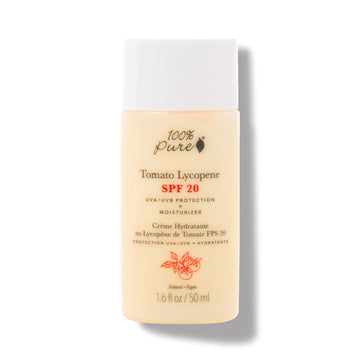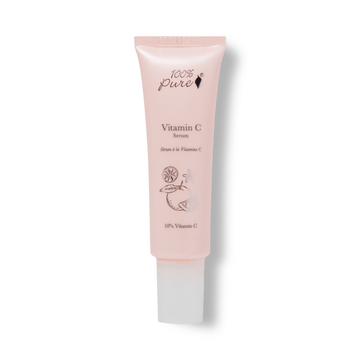Key differences between high and low rating SPF ratings
Written by: 100% PURE ®
While we all want our moment in the sun, UV damage is the main culprit behind saggy skin, age spots, hyperpigmentation, and wrinkles.
As we’ve wised up to the risks associated with high sun exposure, sunscreen has become a staple in our daily skin care. While familiar with the purpose of SPF, we’ve still got questions – especially when it comes to that double digit number.
The American Academy of Dermatology recommends using a broad-spectrum sunscreen rating at least an SPF 30. Why is it that experts tout SPF 30 as the magic number, or at least, a baseline? What does that mean for higher or lower SPF ratings?
The Sun Protection Factor (SPF) rating measures the level of UVB protection a sunscreen provides. This number is supposed to signal how much longer it takes your skin to burn while using that sunscreen properly. With an SPF 30 sunscreen, as an example, your skin would take 30 times longer (than it would unprotected) to develop a sunburn while exposed to UV rays.
Is there that big of a difference between SPF 30 and higher SPF ratings? The American Cancer Society asserts that “higher SPF numbers do mean more protection, but the higher you go, the smaller the difference in protection becomes.”

While scouring for an SPF 100 sunscreen might not be the right game plan, there is a sizable difference between SPF 30 and SPF 50, for instance. According to Dr. Steven Q. Wang, a board-certified dermatologist, an SPF 30 allows 3% of UVB rays to hit our skin while SPF 50 allows 2%. This leads to 50% more UV light hitting your skin.
Keep in mind that SPF rating tests also happen under proper usage conditions. Since certain sunscreens can be greasy or heavy on our skin, we can end up using less sunscreen and receiving less protection. Part of why dermatologists recommend reapplying after 2 hours is because we don’t use enough sunscreen in the first place. Plus, we don’t always reapply sunscreen after sweating a ton or going for swims.
Remember that the SPF rating scale only measures UVB. That’s why it’s important for you to find a broad-spectrum sunscreen; this means protection against UVA rays, too.
PRO TIP: In Korean skin care, the PA rating system measures how much UVA light you can be exposed to without tanning. The system ranges from PA+ to PA++++ (the highest rating).
Experts generally consider SPF 30 the minimum for daily outdoor wear. We know SPF 30 blocks about 97% of UVB rays – compare that to the 93% of UVB rays that SPF 15 blocks.
If you work at an office or work from home, you might think you can forego the sunscreen altogether – not so fast! Windows protect us against most UVB rays, but not as many UVA rays. That’s why it’s still important to use sunscreen when you work or play close to windows. Since windows block a good portion of UV rays, you might find that a SPF 20 sunscreen is suitable for when you’re indoors.
SPF 30 is a useful guideline, but consider that we often apply less sunscreen than we should; this is where a higher SPF can become useful. A higher rating can protect you a little more if you skimp out on your application!

-
If you find that your sunscreen is too thick or heavy, the best thing you can do is experiment with sunscreens to find the right one for your skin type. Chemical sunscreen filters, like avobenzone, can irritate sensitive skin. Instead, opt for a natural mineral sunscreen made with zinc oxide or titanium dioxide.
-
If you sweat heavily or swim while outside, use a water-resistant sunscreen. You still might need to reapply as often as 90 minutes, especially after towel drying.
-
Use a separate SPF product – don’t rely on your foundation’s SPF alone to protect you! You likely don’t use enough product to provide you with full protection, and most sunscreen foundations don’t go higher than SPF 15. Even moisturizer with SPF might not work if you don’t use enough.
-
Don’t forget commonly neglected areas. Among the most forgotten areas are the hands, ears, feet, lips, scalp, hairline, and backs of knees.
-
Use a sunscreen stick for quick reapplication. This is helpful for the backs of our hands, where sunscreen tends to wear off due to handwashing, hand sanitizing, and general use. About 3-4 swipes, or enough to cover the back of your hand, is all you’ll need to stay protected.
-
Wondering how to apply sunscreen without feeling greasy? Try the fingertip application method for liquid SPF. You would apply 2 entire fingers’ worth of sunscreen – use your pointer and middle finger. Use this much sunscreen on your head, neck, and face.
-
Use a vitamin C serum to boost the effectiveness of your sunscreen, especially when combined with antioxidants like vitamin E. Vitamin C serums can prevent more sun damage by neutralizing free radicals that come with UV rays and pollution. Our Vitamin C Serum contains both vitamin C and E to support your SPF efforts, while aloe gel helps with hydration.
-
Supplement your SPF with other protective measures. Stay in the shade, wear a wide hat, and wear protective clothing.
The truth is that SPF 30 may or may not be the magic number for you. While this rating is the bare minimum, we should take into account our application method and environment. Our answer will differ if we’re near windows vs. direct sunlight, exercising heavily or going for a light walk, and using a lightweight or heavy product.
The most important takeaway? Strive to use the suggested amount of sunscreen; you’ll reap the benefits of more smooth, even skin!
- Tags: Bath Body Hair, Body, Skin Care
We carefully hand-select products based on strict purity standards, and only recommend products we feel meet this criteria. 100% PURE™ may earn a small commission for products purchased through affiliate links.
The information in this article is for educational use, and not intended to substitute professional medical advice, diagnosis, or treatment and should not be used as such.













